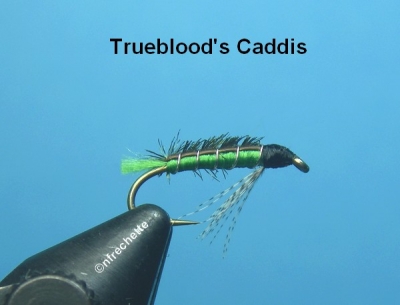Green Silk Caddis
Hook - Mustad Model C49S/Sizes 10 & 12
Thread - Pearsall's Gossamer Silk (Green / No 18)
Hackle - Indian Hen Saddle (Natural Mottled Brown)
Back - Five or Six Strands of Peacock Herl
Body - Pearsall's Marabou Silk (Green / No 18) - Split a silk into individual strands and recombine before wrapping to get a smoother body
Rib - Dubbing Loop created from the long tag end of the tying silk
Abdomen - Peacock Herl reinforces in a silk dubbing loop
I have continued to "massage" this rock worm pattern. This version is tyed with traditional materials (Pearsall's Gossamer & Marabou silk; peacock herl; hen saddle hackle). I've tyed a number of different versions the past couple days and this is the version that makes me happy.
Detailed Tying Instructions:
1) Mount hook in vice
2) Mount your tying thread with five thigh wraps, just behind the eye of the hook. Leave a 6" to 8" long tag end which will be used later on to form the rib of the fly.
3) Prepare an Indian hen hackle by striping the fluff off the base of the feather. Tye it in by the stem, with the feather facing out over the eye of the hook (good side should be facing you). You only need to make four or five tight wraps to secure the feather in place. Break off the seam of the feather by pulling sharply, while holding pressure on your tying thread (saves time).
4) Prepare the peacock herl by lining up the strands with the tips all even. Trim off the thin tips (cut off roughly 2") and tye them in along the top of the hook. Stop wrapping after you have made about ten (10) wraps.
5) Prepare the marabou silk by cutting off a strand roughly 10" long. Untwist the strands until they start to come apart. Using the tip of your scissors, split to strand apart into the individual strands. Eventually you should end up with roughly ten (10) fine silk strands. Recombine the strands and even the ends by trimming off roughly 1/2". Tye the silk strands in along the top of the peacock herl, which is also at the top of the hook. While holding tension on the peacock herl and strands of marabou silk, continue wrapping the tying thread until you get past the barb of the hook.
6) Fold the long tag end of the tying silk (from step 2), and tye it in by the end, to form a dubbing loop. Leave this dubbing loop hanging off the back of the fly, to be used in a later step. Wrap the tying silk back to the front of the hook and stop where you want the thorax to begin. Make sure that your wraps are in closely touching turns.
7) Grasp the marabou silk strands and stroke the silk to smooth and align the fibers. Wrap the marabou silk strands forward to form the abdomen of the fly. You can adjust the taper of the body by making closer wraps (thicker) or by wrapping forwards and backwards over the body a couple times. Once you get to the tying thread, secure it in place with three or four wraps and trim off the excess.
8) Gently grasp the strands of peacock herl and pull them over the back of the fly. Make two loose wraps to hold the herl in place. DO NOT TRIM OFF THE ENDS - They will be used later.
9) Insert a dubbing hook into the dubbing loop (from step 6) and twist it into a tight strand. This will form the rib of the fly, which is used to reinforce the peacock herl and segment the body.
10) Wind the rib forward in open loops. Use your off hand to hold the peacock herl in place, while wrapping the rib. Otherwise it slips off the back.
11) Secure the rib with a few wraps of the tying silk. DO NOT TRIM OFF THE EXCESS DUBBING LOOP - It will be used in a minute to reinforce the peacock herl thorax.
12) Wrap the tying thread forward to the eye of the hook. Leave enough room for the head of the fly.
13) Untwist the dubbing loop and then insert the peacock herl. Retwist into a silk/herl chenille and wrap forward, forming the thorax of the fly. Secure with a couple tight wraps and trim off the excess herl.
14) Grasp the tip of the hackle in a rotary hackle pliers and fold the hackle (all of the hackle fibers should be coming off one side of the hackle stem). Make two wraps of hackle back towards the thorax of the fly. Secure with the tying thread and trim off the excess hackle.
15) Whip finish a neat head and trim off the tying silk.

